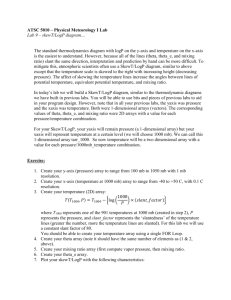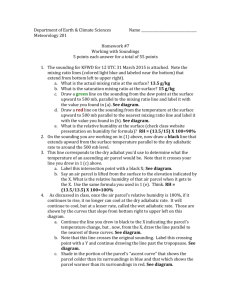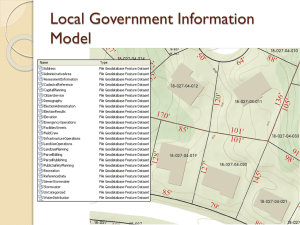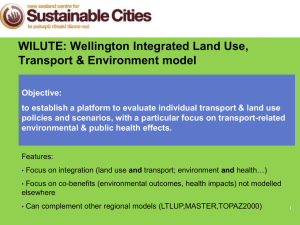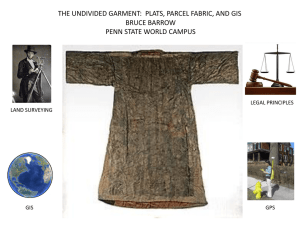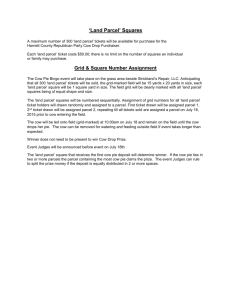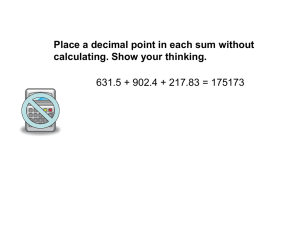Lab #4 - Atmospheric Science
advertisement
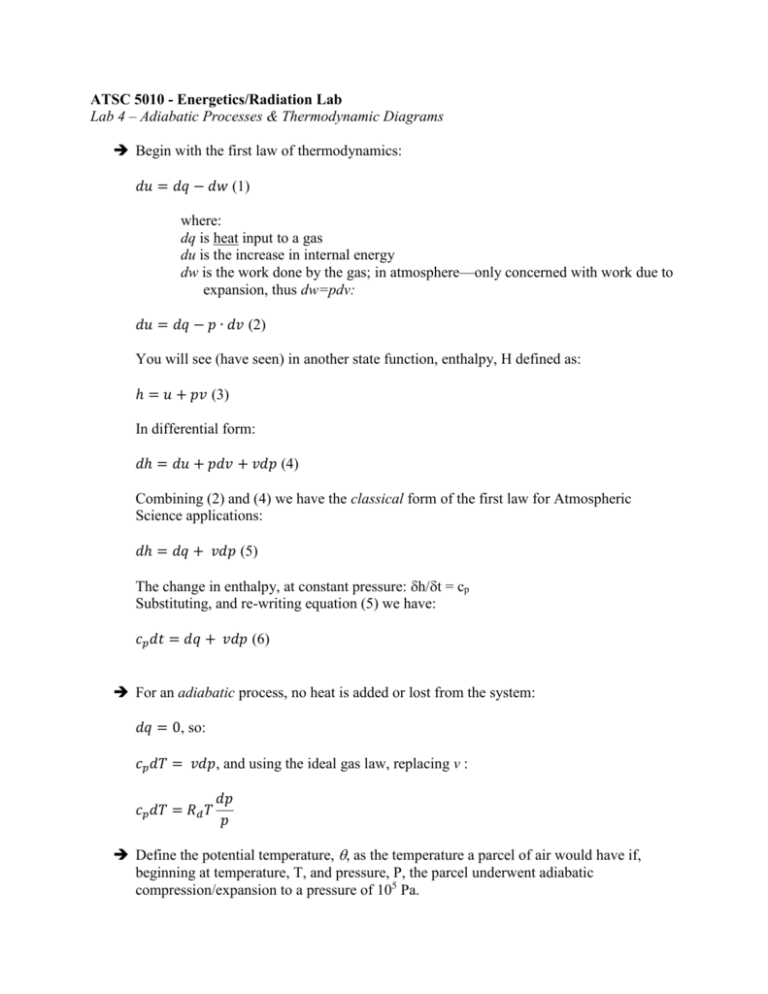
ATSC 5010 - Energetics/Radiation Lab
Lab 4 – Adiabatic Processes & Thermodynamic Diagrams
Begin with the first law of thermodynamics:
𝑑𝑢 = 𝑑𝑞 − 𝑑𝑤 (1)
where:
dq is heat input to a gas
du is the increase in internal energy
dw is the work done by the gas; in atmosphere—only concerned with work due to
expansion, thus dw=pdv:
𝑑𝑢 = 𝑑𝑞 − 𝑝 ∙ 𝑑𝑣 (2)
You will see (have seen) in another state function, enthalpy, H defined as:
ℎ = 𝑢 + 𝑝𝑣 (3)
In differential form:
𝑑ℎ = 𝑑𝑢 + 𝑝𝑑𝑣 + 𝑣𝑑𝑝 (4)
Combining (2) and (4) we have the classical form of the first law for Atmospheric
Science applications:
𝑑ℎ = 𝑑𝑞 + 𝑣𝑑𝑝 (5)
The change in enthalpy, at constant pressure: h/t = cp
Substituting, and re-writing equation (5) we have:
𝑐𝑝 𝑑𝑡 = 𝑑𝑞 + 𝑣𝑑𝑝 (6)
For an adiabatic process, no heat is added or lost from the system:
𝑑𝑞 = 0, so:
𝑐𝑝 𝑑𝑇 = 𝑣𝑑𝑝, and using the ideal gas law, replacing v:
𝑐𝑝 𝑑𝑇 = 𝑅𝑑 𝑇
𝑑𝑝
𝑝
Define the potential temperature, , as the temperature a parcel of air would have if,
beginning at temperature, T, and pressure, P, the parcel underwent adiabatic
compression/expansion to a pressure of 105 Pa.
𝑇
𝑐𝑝 ∫
𝑇0
𝑃
𝑑𝑇
𝑑𝑝
= 𝑅𝑑 ∫
𝑇
𝑃0 𝑝
𝑅𝑑
⁄𝑐𝑝
𝑇
𝑃
= ( )
𝑇0
𝑃0
For P0 equal to 1000 HPa, then T0 is equal to :
𝑅𝑑
⁄𝑐𝑝
105
𝜃 = 𝑇(
)
𝑃
Exercises:
Today you will construct a thermodynamic diagram called an emagram. An emagram can be
used to determine the relationship between temperature, pressure, and potential temperature. You
will use your emagram to answer questions about how a parcel’s state changes as it undergoes
different processes. As in previous labs, your procedure well be named:
‘atsc5010_{yourname}_lab4.pro’
An emagram has an abscissa of temperature and an ordinate of ln(p), with highest pressure at the
bottom part of the graph.
1. In today’s lab you will build a procedure that will construct an emagram with temperature
starting at -30 and and ending at +30 C (x-axis), and pressure starting from 1000 mb and
ending at 200 mb (y-axis). Show temperature gridlines every 10 C and minor tickmarks
every 5 C. Show pressure gridlines every 100 mb.
You should call phycon in your procedure to use any physical constants.
Within your procedure you will first need to create a 1D array of temperatures and 1D
array of pressures over the appropriate range. Create your temperature and pressure
arrays with 0.1C and 1 mb resolution, respectively.
You will then need to create a 2D array of theta (potential temperature) values, where
columns (or rows) represent constant pressure and rows (or columns) represent constant
temperature. By using the matrix multiplier (MATRIX_MULTIPLY function) you can
construct your 2D array without the use of a FOR loop, (you may use a FOR loop, if you
prefer).
Open a window that is 800 pixels in the x-direction and 900 pixels in the y-direction.
Using the “CONTOUR” function produce the emagram onto a window that is 800 pixels
in the x-direction and 900 pixels in the y-direction. Contour theta values versus the
temperature and pressure variables. Contour every 10 K in theta, ranging from 250 K to
470 K, label every other contour (starting with 260 and ranging to 460).
For ease in reading, make your gridlines dotted (or dashed) and make you constant theta
lines thicker and green.
Label your axes.
2. Using your emagram, by hand answer the following questions:
a. If a parcel of air is at 20 C and 600 mb, what is its potential temperature?
b. If that parcel undergoes isothermal compression to 900 mb; what is its new
temperature, pressure and potential temperature? Has the parcel been heated (or
cooled) in this process? If the heat energy has changed, where did it go/come from?
c. Start with a parcel at 20 C and 800 mb. What is the potential temperature? The parcel
then undergoes isobaric cooling to -20 C, what is the new temperature, pressure and
potential temperature of the parcel? Has the heat energy changed during this process?
If so where did it come from?
d. Start with a parcel at 0 C and 800 mb, the parcel then undergoes adiabatic
compression to 900 mb. What is its new temperature, pressure and potential
temperature? Has the parcel been heated (or cooled) during this process?
e. Let the same parcel in (d) then undergo adiabatic expansion to 600 mb. What is the
new temperature, pressure, and potential temperature?
3. After answering the questions in (2) by hand, add to your procedure lines of code that
will utilize the WHERE function within idl to search indices to determine the answers to
the above questions. For Parts (d) and (e) you will also need to use the MIN function.
For example:If you want to know the potential temperature at 0C and 700 mb:
ind1 = (WHERE(temperature EQ 0.0))[0]
ind2 = (WHERE(pressure EQ 700))[0]
print, “at T=10C & P=800mb, Pot. Temperature is: “, theta(ind1,ind2)
*note that WHERE function returns an array of 1 value in the above statement, we
force it to a scalar by placing the function in parantheses and taking the zeroth
element…essentially setting indXX to the first (and only) element in the 1 element
array
2(d) may be a little tricky…If you are searching for a particular value in an array it
may not exist in your array that you are searching…so look for the closest value to
what you are searching. You can do this using the MIN function in idl
For example if I am looking for the index and value in an array that is closest to
the value 5.3:
arr = findgen(10) ;vector of ten values ranging from 0 to 9
val = MIN((arr -5.3), arr_ind, /ABSOLUTE)
In the above example, val is returned with a value of 0.3, arr_ind is returned with
a value of 6. So if you were then to interrogate arr[6] you would find the value in
arr closest to 5.3 is 5.
Procedures/Functions used in making the Emagram:
DINDGEN
MATRIX_MULTIPLY
INDGEN (when you define the levels to contour, see contour procedure)
CONTOUR
Keywords & properties that I used for contour function to make my plot: COLOR,
AXIS_STYLE, YRANGE, XRANGE, YLOG, C_VALUE, C_LABEL_SHOW,
XMINOR, XTICKLEN, XSUBTICKLEN, YTICKLEN, XGRID, YGRID,
YTICKVALUES, XTITLE, YTITLE, TITLE, DIMENSIONS
Note also for contour procedure that your temperature variable will be your X argument,
pressure variable will be your Y argument, and theta variable will be your Z argument
Using MATRIX_MULTIPLY example:
arr1 = [1,2]
arr2 = [3,4]
3 6
1∗3 2∗3
MATRIX_MULTIPLY(arr1,arr2) = [
]=[
]
4 8
1∗4 2∗4
